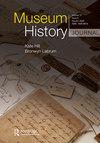Representing the capital of a nation: Zagreb City Museum between Austria-Hungary and Yugoslavia (1907–1925)
IF 0.2
Q3 HISTORY
引用次数: 1
Abstract
ABSTRACT In the nineteenth century, Croatia was a semi-autonomous province in the Hungarian part of the Austro-Hungarian Monarchy. Zagreb was the capital city and the national and political centre. Since most of the Croatian provincial governments in the so-called Dualist Period of Austro-Hungarian history (1867-1918) were formed by pro-Hungarian parties, the Zagreb City Government took on the role of promoting Croatian national identity by launching and supporting cultural projects and initiatives. It was in this atmosphere that the Zagreb City Museum was founded in 1907 as a new institution where narratives about the history and culture of the city started to be shaped through cultural and historical evidence that also served to represent the Croatian nation and national identity formation. This continued in 1918 when Croatia found itself stripped of all autonomy in the Kingdom of Serbs, Croats and Slovenes/ Yugoslavia. The significance of the Zagreb City Museum and the local government in sustaining and reinforcing the Croatian national discourse came to the fore again in 1925 with the celebration of the millennial anniversary of the Croatian kingdom. This article explores the main protagonists and the underlying ideologies behind the early work of the Zagreb City Museum and its nationalist agenda.代表一个国家的首都:奥匈帝国和南斯拉夫之间的萨格勒布城市博物馆(1907–1925)
摘要19世纪,克罗地亚是奥匈帝国匈牙利部分的一个半自治省。萨格勒布是首都,也是国家和政治中心。由于奥匈历史上所谓的二元主义时期(1867-1918)的克罗地亚省政府大多由亲匈牙利政党组成,萨格勒布市政府通过发起和支持文化项目和倡议,发挥了促进克罗地亚民族认同的作用。正是在这种氛围下,萨格勒布城市博物馆于1907年成立,成为一个新的机构,在这里,关于城市历史和文化的叙事开始通过文化和历史证据形成,这些证据也有助于代表克罗地亚民族和民族身份的形成。1918年,克罗地亚发现自己在塞尔维亚、克罗地亚和斯洛文尼亚/南斯拉夫王国被剥夺了所有自治权,这种情况仍在继续。1925年,随着克罗地亚王国成立一千周年的庆祝活动,萨格勒布市博物馆和地方政府在维持和加强克罗地亚民族话语方面的重要性再次凸显出来。本文探讨了萨格勒布城市博物馆早期作品及其民族主义议程背后的主要人物和潜在意识形态。
本文章由计算机程序翻译,如有差异,请以英文原文为准。
求助全文
约1分钟内获得全文
求助全文

 求助内容:
求助内容: 应助结果提醒方式:
应助结果提醒方式:


